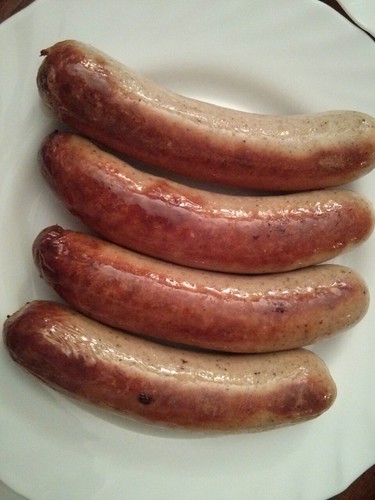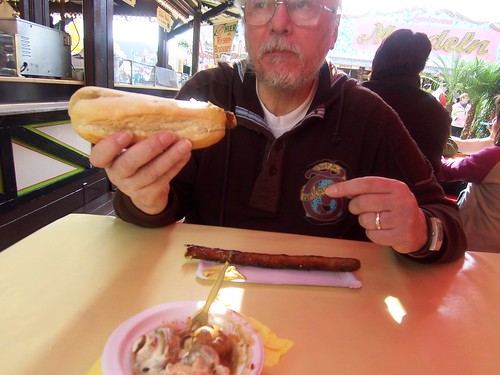25 years after the fall of the Berlin Wall, dividing West and East Germany, some food terms used in the East and used by the "Ossies" , those people who lived in the East side of the wall called the DDR (Deutsche Demokratische Republik) have "survived" and still being used at present.
Here are some of them:
1. Broiler - Brathähnchen/Brathaehnchen - roasted chicken. Nowadays, small mobile trucks or Imbissbude (food stall) are stationed all over Germany selling these delicious food for a cheap price. In Bremen, Germany one whole is being sold for only 6.00 euros.
Picture of the Broiler/Brathaenchen, below sold in Imbissbude and mobile food trucks

The mobile truck below where I buy Brathaenchen when I miss the roasted chicken called Lechong Manok from my home country, the Philippines

2. Ketwurst - a slightly different form of Hotdog served with Ketchup
3. Kochklopse - more popularly known as Königsberger Klopse, Königsberg meatballs which refer to cooked meatballs with capers in a white sauce.
4. Letscho - German term for Hungarian vegetable ragout or stew made of red and green peppers and tomatoes as basic ingredients. Also known in English as Lecho, Hungarian as Lecsó, Czech and Slovak as Lečo, and Polish as Leczo
5. Muckefuck - coffee which is made from grains and not from the usual coffee beans.
6. Roster - popularly known as Bratwurst or roasted sausage. Roster or Bratwurst are also available in small mobile trucks stationed all over Germany selling assorted hot items, like Brathänchen and Pommes frittes and cold salads packed in plastic containers like Sauerkraut, Potato and Macaroni Salads
7. Soljanka - a kind of soup with Letscho
8. Würzfleisch - a ragout which is traditionally made from veal, but Würzfleisch here is made from pork (Schwein) or poultry (Geflügel, such as chicken)
9. Zuckertüte - also known as Schultüte . Translated as school or sweet cone, a paper or cardboard funnel/cone filled with assorted or different kinds of sweets and small gifts which is given to children the first time they enter school.
10. Konsum - refers to Lebensmittelladen which means grocery shop or grocery stores. Known now as Supermarkt-Kette (Supermarket chain)
Brathänchen and Roster are some of the foods I learned to love living in Germany. I am thankful that Brathänchen is readily available here almost everyday, so when I miss food from my home in the Philippines which is called Lechong Manok (Filipino version of roasted chicken) which is almost tasting as the Brathänchen , I can just walk nearby then I’ll be transported back so easily to my home country.
Below is the roasted chicken from the Philippines called Lechong Manok. It is very much the same as the Brathaenchen in Germany, except that in the Philippines, the whole chicken is filled with Tanglad (crushed Lemongrass) beforee roasting. I think , the Brathaenchen in Germany has a delicious taste of special spice mixture prepared by the seller.

Bratwurst is one German food which is not readily available or never been discovered as street food in the Philippines. I still have not been to any place where I can see foodshops selling Bratwurst. What we have in the Philippines are hotdogs, we can roast them, too, but German wurst (sausage) is simply different from any sausage or hotdogs I tasted in some countries I visited, including the Philippines. German Bratwurst is a very simple and yet delicious German food which I want my friends and family to taste if they come to visit me in Germany. I will definitely bring them to an Imbissbude where Bratwurst is at its best
Germany's grilled Bratwurst shown below:

Klaus eating Bratwurst and Krakauer, also one of the popular Würst (Sausages) in Germany.

With regard to Muckefuck which is coffee made from grains, when I was a young girl, I remember my mother roasting regular rice in the mornings when we have no more money to buy a regular coffee (from coffee beans) then use the roasted rice with hot water to serve us coffee. Coming from a poor family, my mother used to get tips from other poor mothers to invent food items which we can’t buy anymore due to lack of money, but needed for our daily survival. I can not remember the taste of my mom’s roasted rice coffee, all I can remember is that , it tasted like any regular arabica coffee sold in supermarkets.
Christmas is fast approaching, I am eagerly waiting for the opening of Weinachmarkt or Christmas Night Market at the center of Bremen where roasted German wurst (Bartwurst, Currywurst, Krakauer) of different varieties are available. Hmmmmm... I am getting excited, I always had fun eating Roasted steaks and Bratwurst with Gluhwein at the Weinachmarkt. I am also thinking of calling my mother from Texas, USA where she is residing now to ask her how to make that roasted rice coffee. I know that she put rice on the pan and cook it without any oil until its burned then put the rice on a pot with water and boil it . I really want her tehcnique pass on to me or any of my siblings just to document everything that she cooked and prepared for us during the days gone by.
